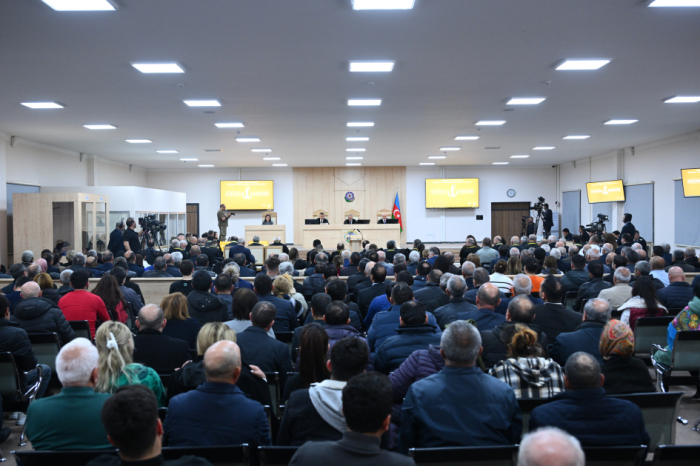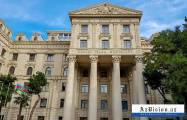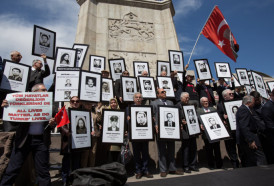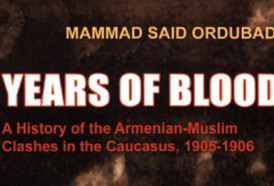Court hearings on the criminal case against citizens of the Republic of Armenia Arayik Harutyunyan, Arkadi Ghukasyan, Bako Sahakyan, Davit Ishkhanyan, Davit Babayan, Lyova Mnatsakanyan and others, who are accused of committing crimes against peace and humanity, war crimes, including the preparation and conduct of a war of aggression, acts of genocide, violation of the laws and customs of warfare, as well as terrorism, financing of terrorism, forcible seizure of power, forcible retention of power and numerous other crimes as a result of Armenia's military aggression, was continued on April 17.
The hearings held at the Baku Military Court were presided over by Judge Zeynal Aghayev and a panel consisting of Jamal Ramazanov and Anar Rzayev (reserve judge Gunel Samadova). Each of the accused was provided with an interpreter into the language of their choice, as well as defense attorneys.
Present at the hearings were the accused and their defense attorneys, some of the victims, their legal successors and representatives, as well as prosecutors in charge of public prosecution.
Judge Zeynal Aghayev explained the rights and obligations stipulated by the legislation to those pf the victims who were participating in the hearings for the first time.
First, the accused Arkady Ghukasyan was questioned about the documents studied at the previous court session. While answering the questions of the prosecutors in charge of public prosecution, he admitted that the Azerbaijanis were forced to leave Khankendi.
When answering the questions of the Senior Assistant to the Prosecutor General, Vusal Aliyev, he said that he had known Robert Kocharyan since 1992, Samvel Babayan since 1993 and Murad Petrosyan since 2000.
In response to a question about the bombing of the bridge over the Khalfalichay river, the accused recalled this incident and said that the developments staged in the territories of Azerbaijan previously occupied by Armenia in 1988-1993 were not heroic but tragic.
Arkady Ghukasyan also said about the massacre perpetrated by Armenian militants in the village of Baghanis Ayrim of Gazakh district in the early hours of March 24, 1990 that it was impossible to have a positive opinion of what happened. He said, “Regardless of who committed those atrocities, it is not right to give them a good assessment. Of course, people who are capable of doing this should be brought to account. There should be only one attitude to that and there can’t be any other assessment.”
Then, the Head of the Department of Public Prosecutions of the Prosecutor General’s Office, Nasir Bayramov, suggested studying the evidence collected in the criminal case on the occupation of the Azerbaijani city of Khojaly by Armenian armed forces and the genocide committed against Azerbaijanis, and then to question the victims.
Materials were disclosed on the numerous criminal incidents committed by Armenians against Azerbaijanis in the district before the Khojaly genocide, as well as some of the documents, evidence and photographic materials collected on the raid on the village of Meshali and the killing of its residents, the looting and burning of houses, shops, cars, and livestock.
Then, documents related to the Meshali massacre were examined. According to the documents, at around 7:00 am on December 23, 1991, Armenian soldiers attacked the village of Meshali, killing 25 people, burning houses, looting the village and taking away the local population's livestock. Vagif Khachaturyan, who was wanted in connection with the criminal case initiated over the incident, was detained. On November 7, 2023, by a judgment of the Baku Military Court, he was sentenced to 15 years in prison.
Then victims gave statements and answered questions from the prosecutors in charge of public prosecution, representatives of the victims, as well as the defense lawyers of the accused.
Victim Elman Mammadov said that in the early hours of February 26, 1992, a total of 613 civilians, including 106 women and 63 children, were killed by Armenian soldiers in a matter of eight to nine hours. What happened in Khojaly that night was the most heinous crime committed against peace and humanity.
He said that the first attack on Khojaly began not only with weapons, but also with ideological preparation during rallies. According to Elman Mammadov, although some sources suggest that the first rally against Khojaly was held on February 13, 1988, the events actually began in Asgaran on February 12.
On September 18, 1988, during a rally in Khankendi, a decision to attack Khojaly was openly announced. According to him, about 10,000 people, including not only the rally participants but also those equipped with weapons and special equipment, marched towards Khojaly.
The victim revealed another fact from that period. “Azerbaijanis were systematically expelled from enterprises operating in Khankendi. Drivers from Khojaly, women working at the Karabakh Silk Factory and the Karshel factory were subjected to violence and torture. More than 70 women from Khojaly worked in the most harmful workshops at those enterprises. Boiling water was poured on them, their hands and feet were crushed, they were insulted.”
Elman Mammadov said that the road to the Khojaly genocide consisted of several stages. One was the complete burning of the village of Meshali in late 1991 and the killing of about 30 villagers. Noting that other villages were also consistently targeted, Elman Mammadov said, “The villages of Jamilli, Malibayli, Gushchular and Garadaghli are not far from each other but are linked into a chain. Every step leading up to the Khojaly genocide was carefully calculated. The masterminds and those who led the process were from regularly represented in the political and military leadership of Armenia”.
Elman Mammadov added that all of those horrific events were the result of Armenia's planned and systematic policy of ethnic cleansing at state level.
Also answering the questions of public prosecutors Fuad Musayev and Vusal Abdullayev, the victim said that before the genocide, Khojaly was subjected not only to attacks, but also to physical destruction under blockade. “On January 28, 1992, the last civilian helicopter flying from Aghdam to Shusha was shot down by Armenians over Khankendi. As a result, about 50 people lost their lives. After this incident, helicopter flights were completely stopped. Thus, Khojaly was in a complete blockade because there was no air other route left,” Elman Mammadov noted.
According to the victim, on February 25, 1992, around the evening, information began to come in from various places about the planned attack of the Armenian armed forces on Khojaly. “This was not just an attack, but a major military operation. Their equipment and numerical superiority were so great that the small force defending Khojaly could not withstand it. The siege lasted about 3 hours. From 11 o'clock at night, the city was shelled with heavy artillery and armored vehicles. The whole of Khojaly was engulfed in flames”, he said.
According to Elman Mammadov, any resistance was out of the question. As a result, the decision was made to evacuate the city. The only way out was in the direction of Aghdam. But the road to Asgaran was under the control of the Armenian military. Therefore, people were forced to move along forest roads. But this was a pre-planned trap too.
He also commented on the claims of a “humanitarian corridor” made by Armenian officials later. He said, “Robert Kocharyan, Serzh Sargsyan, Balasanyan, Seyran Ohanyan – these war criminals themselves later said that they had supposedly provided a “humanitarian corridor”. That corridor did not exist. It was a “death zone” set up to trap the population. Equipment was placed on the hills between Asgaran and Aghdam. The goal was quite clear – to make sure that no one survived Khojaly, so that these atrocities would not be talked about later.
Victim Kubra Mammadova said that she was two and a half years old when Khojaly was occupied. According to her sister, Khojaly was under fire from all sides. When she was leaving their home, her mother tied her to her back and her father tied her sister to his. That night, her father was shot and killed. Her sister Khayala, whom her father had tied to his back, was also shot and died when she tried to run. Then her mother was also killed. Her mother fell to the ground. She untied her from her back, put her down and then fell. When her sister Khatira tried to pick her up, she was also shot and wounded before she lost her consciousness.
The victim also noted that after spending about three days there, they took her from her mother's lap and, thinking that she had frozen to death, brought her to Aghdam district. She woke up when water was splashed on her as she was being washed in the Aghdam city mosque. After that, a nurse at the mosque took her to their home and kept her there for a while. Then, based on a piece of paper his mother had written on her lap, she found some relatives who had been looking for her. After the tragedy, her sister Khayala, her uncle Elman, her mother, and nine days later her father were buried in the Aghdam Martyrs Alley. The Armenians maimed her father's body and scalped it.
Victim Fitat Mammadova said that on that night Khojaly was fired at by various weapons from all sides. They left the city, crossed the Gargar river and went into the Katik forest. As they entered the forest, the Armenians opened fire on her group. A shell exploded nearby, killing her son Gunduz and wounding her.
Answering the questions of the Assistant to the Prosecutor General for Special Assignments, Tugay Rahimli, and public prosecutor Tarana Mammadova, the victim noted that after leaving Khojaly, her husband Salim Hashimov was wounded in the right hand in a place called Gara Gaya near the village of Nakhchivanli. Together with other residents, she was taken hostage by Armenian soldiers and taken to Asgaran, where she was held in a police department’s detention center. Her mother Tamasha Mammadova, along with her brother Rasim Mammadov and other residents of Khojaly, were heading towards the village of Ketik when Armenian soldiers intercepted them with an armored personnel carrier and shot her brother in the forehead. Her other brother Vasif Mammadov was taken prisoner to Asgaran. The Armenians tortured his wife Salima in the detention center of the Asgaran police department, hollowing out his heart. They also tortured her brother Vasif, broke his arms and legs, and then shot him to death. Her nephew Zahir was also captured, wounded and then shot dead.
Victim Zohrab Muradov noted that the first martyr of Khojaly was his brother Zahid Muradov. Armenians fired an “Alazan” rocket, killing one of his brothers and wounding another.
The victim said in his testimony that he had worked at the gas department in Asgaran. In 1987, Armenians fired him because he was Azerbaijani and did not pay his salary for four months. He was in Aghdam when the Khojaly tragedy occurred. The victim saw residents who had fled Khojaly in the village of Shelli, barefoot, wearing only thin clothes, wounded, frozen, with mud all over them. He found out that his brother Zahid, his grandfather Azim and his two children were mercilessly killed by Armenians.
Victim Azer Jabrayilov staid in his testimony that he was 8 years old at the time of the Khojaly genocide. “My mother was martyred shortly before we reached Shelli, while my father, my sister and myself were injured”, he said.
The next hearing is scheduled for April 18.
A total of 15 Armenian nationals are being charged with numerous crimes involving direct leadership and participation of the Armenian state, its state bodies, military forces and illegal armed formations, verbal and written instructions, orders and assignments, provision of material and technical support, central governance, as well as the exercise of rigorous control, with the aim of committing military aggression and acts of terror against the Republic of Azerbaijan in the territory of Azerbaijan in violation of domestic and international law, and involving Robert Sedraki Kocharyan, Serzh Azati Sargsyan, Vazgen Mikaeli Manukyan, Vazgen Zaveni Sargsyan, Samvel Andraniki Babayan, Vitali Mikaeli Balasanyan, Zori Hayki Balayan, Seyran Mushegi Ohanyan, Arshavir Surenovich Garamyan, Monte Charles Melkonyan and others, including criminal acts committed during the course of the war of aggression waged by the aforementioned criminal group.
The said persons, i.e. Arayik Vladimiri Harutyunyan, Arkadi Arshaviri Ghukasyan, Bako Sahaki Sahakyan, Davit Rubeni Ishkhanyan, David Azatini Manukyan, Davit Klimi Babayan, Levon Henrikovich Mnatsakanyan, Vasili Ivani Beglaryan, Erik Roberti Ghazaryan, Davit Nelsoni Allahverdiyan, Gurgen Homeri Stepanyan, Levon Romiki Balayan, Madat Arakelovich Babayan, Garik Grigori Martirosyan, Melikset Vladimiri Pashayan, are being charged under Articles 100 (planning, preparing, initiating and waging a war of aggression), 102 (attacking persons or organizations enjoying international protection), 103 (genocide), 105 (extermination of the population), 106 (enslaving), 107 (deportation or forced displacement of the population), 109 (persecution), 110 (enforced disappearance of people), 112 (deprivation of liberty contrary to international law), 113 (torture), 114 (mercenary service), 115 (violation of the laws and customs of warfare), 116 (violation of international humanitarian law during armed conflict), 118 (military robbery), 120 (intentional murder), 192 (illegal entrepreneurship), 214 (terrorism), 214-1 (financing terrorism), 218 (creation of a criminal association (organization)), 228 (illegal acquisition, transfer, sale, storage, transportation and possession of weapons, their components, ammunition, explosives and devices), 270-1 (acts threatening aviation security), 277 (assassination of a state official or public figure), 278 (forcible seizure and retention of power, forcible change of the constitutional structure of the state), 279 (creation of armed formations and groups not provided for by law) and other articles of the Criminal Code of the Republic of Azerbaijan.
More about:
















































